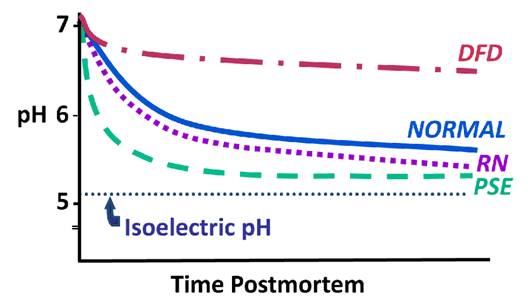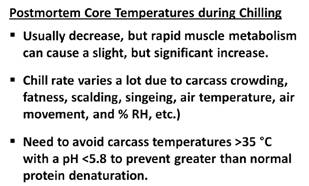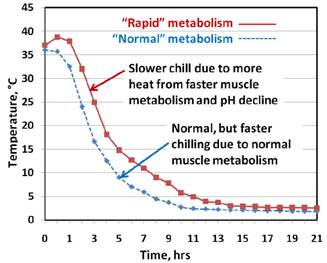Conversion of Muscle-to-Meat Issues and WHC
The conversion of muscle to meat actually starts when someone decides to sell and market their pigs because this is when ante-mortem stress occurs with the marketing and handling of animals. The physical and chemical changes occurring in muscle after an animal dies are very important parts of the conversion of muscle into meat. The combination of the timing and occurrence of early post-mortem events and the process known as rigor mortis (muscle stiffening) have tremendous impact upon many meat properties important to processors and consumers.
Knowledge of the nature, the extent, and the rate of the changes occurring in muscle the first few hours post-mortem is needed to understand meat's WHC, emulsifying capacities, color, tenderness, juiciness, firmness, and susceptibility to bacterial growth. In addition, understanding rigor mortis will aid in the application of many meat processing techniques that depend on WHC including: electrical stimulation, hot-boning, chilling, freezing, heating, pressurization, chopping, cutting, and forming.
- Exsanguination (Blood Removal): Immediately after bleeding, when the animal is dead (but the muscle is still responsive) muscle cells shift their energy (ATP) production from aerobic biochemical pathways to anaerobic processes. Two critical events occur with this metabolic shift. The ATP production is much less and cannot sustain normal muscle-energy needs. Without sufficient ATP, calcium is released from the sub-cellular sarcoplasmic reticulum (SR) and the muscle proteins start to form cross-bridges (irreversible muscle contraction) and the onset phase of rigor mortis occurs. Secondly, a new byproduct (lactic acid) is created by the anaerobic metabolism of glycogen and the pH starts to decline.
- Decline in Muscle pH: The pH of living tissue is about 7.0, but after rigor, the pH of meat is normally about 5.5 to 5.7 (see Fig. II-4). The increased acidity of post-mortem muscle results from the accumulation of lactic acid, which is formed as glycogen is degraded (anaerobic glycolysis) to produce ATP. Animals that are not handled optimally ante-mortem will likely have faster running muscle biochemistry and a more rapid decline in muscle pH. This change in pH during the conversion of muscle to meat is perhaps the most important event because it affects so many chemical, physical, and sensory traits of meat products.
Muscle pH is critically important because both the rate and extent of pH decline greatly affect meat properties. If the pH decline is rapid and reaches 5.5 to 5.8 while the muscle temperature is still high (more than 36 °C), the meat may become PSE. This condition is compounded by slow chilling. Conversely, if the animal's energy supply (glycogen) is exhausted before slaughter, the muscle pH will be abnormally high (6.0 to 7.0) making the meat appear DFD. The pH fails to decline since there is not enough glycogen present in the muscle at death to form normal levels of lactic acid in the meat. This muscle goes into rigor rapidly and is more susceptible to bacterial spoilage than normal or PSE meat. The PSE and RN curves were discussed in a previous section (Role of Animal Genetics and WHC).

Figure II-4. Changes in pH Post-mortem
The extent of the pH decline varies slightly between muscles and even within a muscle. Muscles and area within a muscle with more red fibers (darker red color, smaller, slower contracting, more aerobic cells) will have a slightly higher pH than muscles or areas that are more "white" (lighter color, larger, faster contracting, more anaerobic cells) will be slightly lower).
- Muscle Temperature vs. pH: During the early hours post-mortem when muscle is particularly sensitive to insult, there is a critically important interaction occurring (Fig. II-4 and II.5) between the pH and temperature of muscle that affects the extent of muscle shortening (contraction), protein denaturation, meat color, firmness, and WHC in the muscle. If the meat is exposed to either high (35-38 °C), low (2-10 °C) or freezing temperatures before the muscle pH is 6.0 or lower, undesirable effects such as toughening, cut distortion, excess juice loss, and poor WHC may develop.


Figure II-5. Effects of carcass chilling and pH decline on meat quality.
Most of these changes are due either to shorter sarcomeres or to decreases in protein solubility (denatured protein) caused by the rapidly dropping pH while the meat is still warm. For pork (Fig. II-5), if the muscle chemistry is running faster than normal, then more rapid chilling needs to be applied; however, complete freezing of the tissue also produces undesirable effects that lower WHC. There is a fine line between chilling rapidly by using ultra-chill systems that accelerate chilling by freezing of the outer layers of carcass tissue and then following with carcass temperature tempering at a temperature above freezing of meat than freezing carcasses prior to rigor onset.